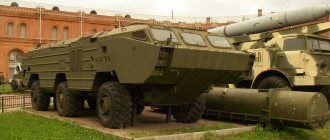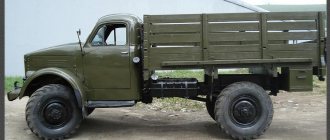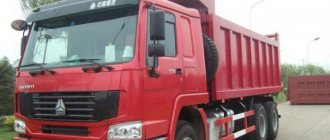MAZ-525. About the history of the model
The first development of a truck of this class began in 1947 at the Yaroslavl Automobile Plant, under the leadership of the heavy-duty vehicle design bureau under the Ministry of Automotive Industry of the Soviet Union. This project was initially given the code name YAZ-225. On this new truck it was initially planned to install a cabin shifted to the left from the YaAZ-200 vehicle. However, subsequently the technical documentation was transferred to MAZ, where the design of the dump truck was seriously reworked.
The task of developing and launching the MAZ-525 was solved by a team of designers led by Boris Lvovich Shaposhnik, the future head of the MAZ Design Bureau, which created multi-axle tractor-rocket carriers.
The MAZ-525 mining dump truck has become a fundamentally new type of truck for the domestic automotive industry. Nothing like this had ever been produced in the Soviet Union before. The prototype MAZ-525 was made in September 1950.
In addition to outstanding weight and size characteristics, it was also distinguished by quite progressive technical solutions for that time. In particular, the MAZ-525 was the first in our country to use hydraulic power steering, a body lifting mechanism with a hydraulic pump separate from the working cylinders, and planetary gearboxes built into the wheel hubs.
The MAZ-525 mining dump truck became the flagship of the domestic truck industry at that time. The Minsk Automobile Plant was proud of it, which, soon after assembling the first prototypes in 1950, began mass production of this model in 1951.
In the first years of production, several dozen MAZ-525s were made annually; in 1954, for the first time, they exceeded the bar of one hundred trucks built per year. And the production record came in 1958, when 231 MAZ-525 dump trucks were assembled in Minsk.
Only this was not enough to meet the needs of the economy of our huge country. Therefore, the production of MAZ-525 was transferred to a separate industrial site, in Zhodino, to the plant of road and reclamation machines, which later became the famous BelAZ.
The world-famous automobile plant, which has been producing increasingly modern and advanced giant mining dump trucks for many years, grew out of the Zhodino Mechanical Plant, which made road and reclamation machines. On April 17, 1958, it was renamed the Belarusian Automobile Plant, and Nikolai Ivanovich Derevyanko, deputy, became the director of this new enterprise. director of MAZ.
The team he headed was faced with the task of not only launching serial production of new heavy dump trucks in a short time, but also creating an assembly line for this. After all, no one anywhere in the world has ever produced large mining trucks using a conveyor belt before.
The first Zhodino MAZ-525 from components supplied by the Minsk Automobile Plant was assembled on November 1, 1958, despite the fact that much of the equipment had not yet even been put into operation. However, already in October 1960, when the conveyor line was debugged, its own pressing and welding production was launched, and the production of main components and assemblies was mastered, the Belarusian Automobile Plant delivered its thousandth MAZ-525 dump truck to its customers.
Only in 1958, the MAZ-525 was assembled in parallel in both Minsk and Zhodino. In 1959, the last few MAZ-525s were assembled in Minsk. And BelAZ produced 432 of them in 1959. Then production volumes at BelAZ only increased. The record year was 1964, when 1,115 MAZ-525 dump trucks were manufactured per year.
The result of the production of MAZ-525 is as follows: 940 trucks of this model were built in Minsk from 1951 to 1959, then 6021 dump trucks were assembled by BelAZ - in the period from 1958 to 1965. The total number of MAZ-525s that entered the national economy of the Soviet Union was 6,961 trucks over the 15 years of its production.
The last MAZ-525 was solemnly escorted into the “big life” from the Zhodino factory assembly line on September 11, 1965, after which the Belarusian Automobile Plant completely switched to the production of new BelAZ-540A dump trucks. Some sources erroneously indicate that the MAZ-525 was produced until 1967. This is wrong. Although, of course, the plant continued to produce spare parts, components and assemblies for it in large quantities for several years.
Progress is inevitable
Then at BelAz they widely launched the production of a simple quarry “hard worker”, which had been assembled before. Hundreds of new dump trucks have reached different countries, in all directions. And this path turned out to be the most correct, since it gave impetus to the start of production of today's supergiants, such as the Belaz-75710, which is capable of transporting 360 tons of any quarry cargo at a time, and even unloading it in parts where the surveyor indicates.
MAZ-525 dump trucks in action
MAZ-525 mining dump trucks participated in almost all major Soviet construction projects of the 1950-1960s, and in foreign ones too. For example, they worked on the construction of the Aswan Dam on the Nile in Egypt. The construction was grandiose: 430 million were invested in its foundation. cubic meters of soil. MAZ-525 trucks helped block the Yenisei. This is what the only surviving copy of this dump truck, installed as a monument at the Krasnoyarsk hydroelectric power station, reminds of.
There is another monument where a dump truck similar to a MAZ-525 is installed on a pedestal. It stands in Krivoy Rog, on the territory of a mining and processing plant. However, this is not a MAZ-525. The BelAZ-548 chassis is equipped with an extended cabin from the KraZ-256B, the body and hood are welded “based on” the MAZ-525. The result is a “hodgepodge” in which there is nothing from the original first Soviet quarry.
Covering the Yenisei. 1963
Intensive operation has revealed a number of significant shortcomings inherent in MAZ-525 dump trucks. First of all, we were talking about an overweight, too metal-intensive structure, an ineffective transmission, extremely low speed and a rigid, unsprung rear axle. In this regard, already in 1960, the designers of the Belarusian Automobile Plant began designing a fundamentally new BelAZ-540 mining dump truck, which became the ancestor of an extensive family of Zhodino giant cars that have been bearing the BelAZ brand for many years. This new generation mining dump truck replaced the MAZ-525 on the assembly line, the production of which was discontinued in 1965.
In general, the life of these cars was short-lived. The extreme operating conditions in which they had to work took their toll. Only rare machines survived in working condition until the late 1970s. Then, on the move, only very rare, single copies could be seen - in the form of alterations, adapted for in-plant transport.
Start of release
Serial production of the car began in 1950 and continued until 1959. During this period, more than 800 MAZ-525 dump trucks were produced. The exterior of the car from different years of production was approximately the same; the manufacturer was not faced with the task of making the car more attractive. All attention was focused only on technical issues aimed at improving driving performance and increasing load capacity.
Nevertheless, some symbols needed to be marked on the machine. A popular Belarusian animal was chosen for the role of a symbolic image - the bison. A small chrome figurine of a powerful wild bull was placed on both sides of the MAZ-525 hood. On later batches of dump trucks, the “bison” was simply stamped on the side panel of the hood.
Evolution of the model
The appearance of the MAZ-525 dump truck changed several times during serial production. For example, the hood at the base was initially equal to the width of the cabin, but later they began to make it much narrower, saving metal on this. On MAZ-525 trucks in the first years of production, the radiator grille looked similar to the MAZ-200 grille. Then the semicircular radiator trim was replaced with a rectangular one.
The contact-oil air cleaner, which did not fit under the hood, was first installed on the left side of it, and then on the right. Real practical experience in dusty quarries pushed the manufacturer to install two filters on the machine at once.
Or: to ensure the safety of drivers and mechanics when servicing the diesel engine on this tall car, at first a guard was mounted on the sides of the hood, but then it was decided to abandon this decision. These small safety railings on the front fenders have been removed for good. The number of vertical stiffeners on the body changed: it varied from seven to six.
The chrome-plated figurine of a bison, which was initially placed on the hoods of MAZ-525 trucks, was later “divided into two parts”, and the emblem was attached in the form of bas-reliefs (stampings) to the sides of the hood. And then they began to install it “every once in a while” - not on every car. When the production of MAZ-525 cars was transferred from Minsk to Zhodino, to the Belarusian Automobile Plant, the bison from the hood completely disappeared. And in their place new inscriptions appeared - a series of letters “Belarusian Automobile Plant”.
Zhodino today
But before the era of giants with electric drives on all wheels comes, Zhodino set about developing the BelAz-540, the ancestor of the galaxy “75710” and others like it. And the production of MAZ-525 ended in 1965, and this car will never be forgotten, because it is an example of a true worker. Monuments to the “five hundred and twenty-fifth” are erected wherever the memory of the dump truck is preserved.
“Zhodino” is currently an international center of pilgrimage for business executives from all over the world. Dump trucks with a carrying capacity of 360 to 540 tons suddenly became needed by blacks in Africa and the Aleutians in the Far North. There will always be quarrying, more and more minerals are being mined. In addition, the cost of orange giants is an order of magnitude lower than the Japanese Kamatsu or American Caterpillars. So take a direct course to Zhodino!
Engine and transmission MAZ-525
Dump trucks of this model were equipped with twelve-cylinder tank diesel uncompressor engines D-12A, derated from 450 hp. up to 300 hp RPM – 1500 per minute. The minimum idle speed is 500, the maximum is 1700 rpm.
The working volume of this engine was 39 liters (38,880 cm3).
D-12 is a Soviet V-shaped 12-cylinder four-stroke diesel tank engine, water-cooled, 24-valve, with direct diesel fuel injection. The two cylinder blocks are arranged in a V-shape at an angle of 60°. Compression ratio – 14:1. Cylinder diameter – 150 mm. The piston stroke is 180 mm (left) and 186.7 mm (right).
A hydraulic coupling (fluid coupling) is mounted on the crankshaft flange of the MAZ-525 car engine.
A three-section gear oil pump was installed on the engine. It had three sections: two pumping and one pumping.
Air was sucked into each cylinder block through separate air ducts, through two inertial-type air cleaners.
The diesel engines of MAZ-525 cars were equipped with booster pumps of the BNK-12TS brand. Diesel fuel was supplied to the injectors by a twelve-plunger high-pressure fuel pump.
In front of the engine there is a radiator for the engine cooling system and a fan driven by the crankshaft through a V-belt drive.
On MAZ-525 vehicles there were two fuel tanks, connected to each other and installed behind the cab. Diesel fuel from the right tank was supplied through a pipeline to the fuel priming pump, which ensured a continuous supply of fuel.
MAZ-530, MAZ-525, MAZ-205
The D-12 engine traces its history back to the famous V-2 tank diesel engine, developed in the late 1930s at the Kharkov Locomotive Plant. This engine (in various modifications) was installed on the main Soviet tanks - BT-7, KV, IS and, of course, on the legendary “weapon of Victory” - T-34; for heavy artillery tractors "Voroshilovets".
Based on the V-2 engines, in the second half of the 1940s - early 1950s, lightweight diesel engines for various sectors of the national economy were created and put into mass production at Barnaultransmash - first six-cylinder D-6, and then 12-cylinder D -12. Both six- and twelve-cylinder diesel engines are widely used on river vessels. D-12 was also used on diesel locomotives, bulldozers and military engineering vehicles (on a tank chassis).
It is combined with a fluid coupling protecting the transmission and installed immediately behind it. The gearbox on the MAZ-525 is a mechanical four-way, with five forward gears and one reverse gear. The gearbox is made in a single unit with a clutch and is attached to the frame brackets through rubber shock absorbers.
Suspension and chassis; cargo platform
The car frame is a welded spar frame, made of 36C beams, reinforced with overlays.
The rear axle, unlike the front axle, was rigidly attached to the frame, without any springs - the beam was bolted directly to the car frame. It was believed that no suspension could withstand the shock loads that occur when loading a dump truck with massive boulders.
In order to absorb the shock of the load loaded by the excavator, the bottom of the body was made double, made of powerful steel sheets with an oak gasket between them. Loads were transmitted directly to the frame through six rubber pads. Well, the main shock absorber was huge wheels with a tire diameter of 172 cm.
The front suspension is on two longitudinal semi-elliptic springs.
Cargo dump platform – metal, welded, bucket type. The floor is double, with a wooden layer between the sheets; in the rear, the floor is inclined (at an angle of 20 degrees); the front side is double. The front part of the platform is limited from lateral movements by two brackets.
The tipping mechanism of the dumping platform is hydraulic, with two telescopic cylinders. The tilt angle of the body is 65 degrees. To protect the cabin from impacts during loading, the platform had a protective visor in the front part.
Modifications
At the turn of the 1950s and 1960s, an attempt was made in Zhodino to create a MAZ-525A truck tractor, based on the main model, for working as a road train with a single-axle tipper semi-trailer of its own design, BelAZ-5271, with a load capacity of 45 tons of rock or soil. However, this development was considered unsuccessful, and the MAZ-525A tractor did not go into mass production. Only a semi-trailer from it was put into production in 1962, already with a completely new tractor model BelAZ-540A.
Just a year after the start of mass production of the MAZ-525 mining dump truck, the Minsk Automobile Plant produced the MAZ-E-525D truck tractor based on this truck. This vehicle was designed to work in conjunction with a 15 cc D-189 scraper. However, he could cope with it alone only when moving empty and when simply transporting cargo. When the body was filled, a pusher was added to the road train - the same MAZ-E-525D with ballast over the rear axle. The pusher worked not with one, but with several scrapers at once, so this type of work was quite effective.
A fully loaded tractor moved at a speed of 28 km/h. It had the following dimensions: 6730 x 3210 x 3400 mm, and a wheelbase of 4000 mm, which is 780 mm less than the dump truck on which it was based. Behind the cab of the MAZ-E-525D truck, a motor-driven winch with a traction force of up to 3500 kg was installed to control the scraper.
A new word in mechanical engineering was the trolley truck - an electric dump truck, created in 1954 by specialists from the Institute of Mining of the Academy of Sciences of the Ukrainian SSR, the Kharkov Trolleybus Depot and the Soyuznerud Trust. Earlier, in 1952, the designers had already “practised” in creating trolley carriers, making them on the chassis of the MAZ-205 and YaAZ-210E dump trucks. Two years later it was the turn of the 25-ton MAZ-525.
According to the project developers, the use of trolley-electric dump trucks should have significantly increased the operating efficiency of trucks of this “caliber”. The trolley vehicle on the chassis of the quarry MAZ-525 was equipped with two DK-202 trolleybus electric motors with a total power of 172 kW (234 hp), which were controlled by one controller and four contact panels of the TP-18 or TP-19 type. The electric motors also powered the power steering and the lifting device of the dump truck.
The supply of electrical energy from the power plant to the engines of trolley trucks was carried out in the same way as with conventional trolley buses: along the route of their work it was necessary to stretch the wires, which the electric dump trucks touched with two arcs mounted on the roof of their current collectors.
In 1964, NAMI (Research Automotive and Motor Institute) developed another experimental model of a trolley dump truck based on the MAZ-525, called DTU-25.
Also in 1959, based on the MAZ-525, 3 units of the MAZ-541 wheeled airfield tractor were produced.
Career orientation
The problem had been brewing for a long time, so the decision was made quickly. In 1951, the MAZ-525 mining dump truck went into mass production. The design changes were insignificant; the radiator grille was made straight from a semicircular one, and the paraphernalia was removed from the wings.
The car was equipped with a three-hundred-horsepower Barnaul engine with 12 V-shaped cylinders. The giant's wheels were more than two meters in diameter. The carrying capacity increased to 25 tons, then it was possible to add another 5 tons, in total the MAZ-525 began to lift thirty tons, and this was a real breakthrough.
Technical characteristics of the MAZ-525 in numbers
- Dimensional parameters: length – 8305 mm, width – 3220 mm, height – 3675 mm.
- Weight parameters: curb weight – 24380 kg. In this case, the weight distribution along the axles is as follows: 11,200 kg on the front axle and 13,180 kg on the rear axle. The vehicle's carrying capacity is 25,000 kg.
- Body volume is 14.3 cubic meters.
- Internal body dimensions: 4700 x 2950 mm; side height – 1200 mm.
- Wheelbase (distance between axles) – 4780 mm.
- Ground clearance – 460 mm (under the housing of the driving rear axle); 700 mm (under the front axle).
- Track width – 2500 mm (between the front wheels); 2200 mm (between the middles of the rear slopes).
- The smallest turning radius along the front outer wheel track is 12 m.
- Overhang angles, with full load: front - 33 degrees, rear - 62 degrees.
- Maximum speed – 30 km/h.
- The control diesel fuel consumption is 135 liters per 100 km (when driving at full load on a dry, flat road).
- The total capacity of the fuel tanks (2, communicating with each other) is 400 liters.
- Tire size: 17.00-32.
MAZ-525 in 2006 on the territory of the Minsk Motor Plant - converted into a crane for transporting machine tools and other heavy equipment. A couple of years later it went to scrap metal
Of course, by today's standards, the capacity of the body of this first Soviet mining dump truck, the MAZ-525, is not at all amazing. Indeed, in our time, ordinary dump trucks, which are intended for use on public roads, take on board no less volume of cargo. But by the standards of the mid-twentieth century, transferring over fourteen cubic meters of cargo in one flight was considered a serious achievement. After all, even the largest Soviet road dump truck at that time, the YaAZ-210E, had a body capacity that was six cubic meters less.
Owner reviews and prices
Nikolay, site manager
A MAZ-5551 dump truck is used at the construction site. Now prices for such a new car are about $10,000. But in our construction industry, the truck is rented. The rental price is 8,500 rubles for 1 shift. The car transports sand, bricks, and concrete blocks.
Alexander, driver
I work as a MAZ dump truck driver. This is an excellent vehicle with a high load capacity, equipped with a comfortable cabin and an excellent panoramic windshield. The machine works properly and is easy to maintain and repair.











